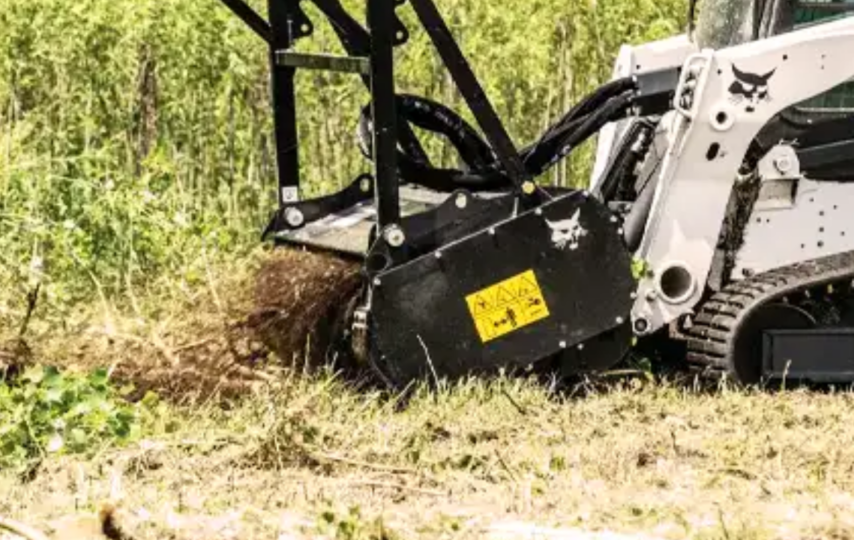Tree removal frequently leaves an unattractive reminder of the persistent stump. Stump grinders have emerged as vital instruments in the arsenals of arborists, landscapers, and property owners looking to remove these relics efficiently. The stump grinder teeth are the unsung heroes at the heart of these grinding machines.
With their sharp edges and sturdy designs, these teeth are the workhorses responsible for converting once-mighty tree stumps into mulch. Understanding the subtle elements that influence the performance of these teeth is critical for optimizing the grinding process.
In this detailed tutorial, we will look at the numerous factors that must be considered when determining the effectiveness of stump grinder teeth. By navigating these elements, users can better understand how to maximize the lifespan and efficiency of stump grinder teeth, resulting in a smoother and more successful stump removal operation.
Working Process Of Stump Grinder Teeth
The working process of a stump grinder depends on the following factors:
- Contact And Cutting Action
Stump grinder teeth work by turning a cutting wheel that is often outfitted with many sharp, projecting teeth. The teeth of the cutting wheel make direct contact with the surface of the stump as it spins at high speeds. The cutting operation resembles a succession of precise and powerful chiseling motions. The teeth’s sharp edges pierce the wood, breaking it down into smaller, more manageable pieces. The grinding operation is repeated until the stump is reduced to mulch or sawdust, depending on the settings of the grinder.
- Grinding Depth And Precision
The operator and the design of the stump grinder teeth regulate the depth and precision of the grinding process. Changing the cutting wheel’s height or angle of attack enables customization based on the job’s requirements. Some grinders are built for more delicate operations that require greater precision, while others excel at removing huge stumps quickly. The design of the teeth and the overall layout of the cutting wheel determine their performance in these jobs.
- Types Of Stump Grinder Teeth
There are several types of stump grinder teeth, each designed for a unique function. Straight teeth, for example, are great for quick and vigorous grinding, whereas convex or concave teeth provide distinct benefits. The tooth type chosen is determined by criteria like as the size and hardness of the stumps as well as the intended output. Stump grinder teeth’ versatility provides adaptability to a variety of grinding settings.
- Material Removal And Efficiency
Material removal efficiency is an important component of vermeer stump grinder teeth performance. How quickly and effectively the wood is reduced to trash is determined by the sharpness of the teeth paired with the power of the grinding machine. Well-kept teeth improve the overall efficiency of the stump grinding process, allowing for smoother operations and faster task completion.
Factors Affecting The Performance Of Stump Grinder Teeth
Stump grinders are crucial instruments for efficiently removing tree stumps, and the efficiency of these machines is strongly dependent on the quality of their teeth. Stump grinder teeth, the cutting components responsible for grinding through wood, play a critical role in the device’s overall performance. This article will look into the numerous elements influencing stump grinder teeth’ performance, giving users complete guidance.
- Wood Hardness And Composition
The hardness and content of the wood being processed have a major impact on the performance of stump grinder teeth. Hardwoods, such as oak or hickory, are harder on the teeth than softer woods, such as pine. The density and fiber structure of the wood can influence how quickly the teeth wear out and how frequently they need to be replaced or sharpened.
- Tooth Type And Design
Stump grinder teeth are available in a variety of shapes and sizes, each suited to a specific application. The choice of straight, convex, concave, or other tooth kinds is determined by criteria such as stump size and the desired level of precision in grinding. The shape of the teeth also determines how well they cut and handle different types of wood. Operators should be aware of the available tooth alternatives and choose the best ones for their stump-grinding projects based on the nature of their stump-grinding operations.
- Frequency Of Use And Work Conditions
The frequency with which a stump grinder is operated, as well as the working conditions, have a significant impact on tooth performance. Tooth wear can be accelerated by frequent use or working in abrasive environments, such as sandy or rocky soil. Understanding the expected workload and environmental circumstances assists users in developing maintenance routines, such as sharpening and replacement schedules, to maintain consistent performance and longevity of the teeth.
- Proper Maintenance Practices
Regular maintenance is critical for stump grinder teeth to work optimally. Routine inspections for signs of wear, damage, or misalignment are included. Sharpening processes that adhere to manufacturer standards help to keep teeth sharp. Cleaning the teeth after each use to remove debris and resin buildup helps them last longer.
- Tooth Sharpness And Edge Retention
The cutting efficiency of stump grinder teeth is directly proportional to their sharpness. Dull teeth not only limit performance but also put additional strain on the grinding system as a whole. Regular sharpening, using appropriate equipment and techniques, is required to keep teeth sharp. Understanding the relationship between sharpening frequency and tooth lifespan is critical for obtaining peak performance while minimizing wear.
- Matching Teeth To Stump Grinder Model
Using the correct type and size of teeth for a certain stump grinder model is sometimes disregarded, yet it is a vital aspect of performance. Each grinder model is designed to perform best with specific types of teeth. Mismatched teeth can cause inefficiencies, higher wear, and potential damage to both the teeth and the machine. Always follow the manufacturer’s instructions and standards to guarantee optimum tooth compatibility.
Final Words
A variety of factors influence stump grinder tooth performance, ranging from the type of wood being processed to correct maintenance techniques. Understanding these aspects and applying suitable steps can help users improve the efficiency and longevity of their stump grinder teeth. Regular inspections, careful tooth selection, and adherence to maintenance instructions are critical to ensuring that stump grinders run optimally and deliver effective and dependable stump removal.








